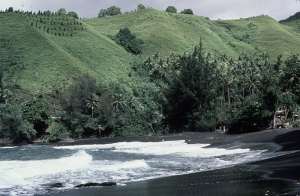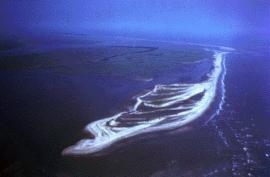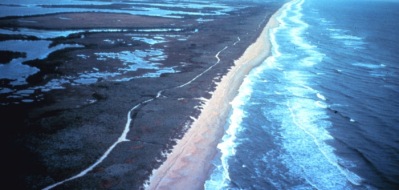Depositional Coastal LandformsBeachesA beach is a deposit of loose sediment adjacent to a body of
water. Though sand is common to most beaches, a remarkable diversity of
sediment size, from boulders to fine silt is found on beaches around the
world. Larger particles and steeper slopes are found where wave action
is high. Fine particles and gentle slopes are characteristic of beaches
exposed to low wave action. Figure 21.13 Black lava beach, Tahiti Most midlatitude beaches undergo a cycle of erosion and deposition following the seasonal changes in wave action. During the winter, midlatitude storms are more vigorous producing more wave action and erosion. Hence, beaches tend to narrow during the winter. Wave action subsides during the summer as storms weaken somewhat favoring deposition over erosion and producing broader beaches. Spits and barsA sand spit is one of the most common coastal landforms. A sand spit is a linear accumulation of sediment that is attached to land at one end. Sand carried parallel to shore by longshore drift may eventually extend across a bay or between headlands especially where water is relatively calm. Spits are typically elongate, narrow features built to several dozen feet by wind and waves.
Spits often form when wave energy decreases as a result of wave refraction in a bay. When a coastline turns abruptly, wave energy is dissipated by divergence of wave trajectories, causing sediment to accumulate as the water loses its ability to transport. Spits can extend across the mouth of a bay, but wave action is usually strong enough to wash sand out to sea or be deposited in the embayment. They may curve into the bay or stretch across connecting to the other side as a baymouth bar. When the bay is closed off by a bar it becomes a lagoon. Wave energy also dissipates in the lee of large sea stacks or islets.
Wave refraction sweeps sediment behind the obstruction from two
directions, depositing it as a slender finger called a tombolo.
Barrier IslandsCoastlines paralleled by offshore narrow strips of sand dunes, salt
marshes and beaches are known as barrier islands. Barrier
island complexes stretch along the southeastern coast of North
America from Long Island, New York to the Gulf coast of Texas.
Many believe barrier islands originated as offshore bars built by waves
breaking on a shallow shore. When waves begin to feel the tug of the
ocean floor, they push sand toward shore as they break. The return
undertow sweeps sand back to settle on the developing bar. These
offshore bars were later exposed when the continent rebounded after ice
age glaciers melted. Figure 21.15 Canaveral National Seashore is located along Florida's Central East Coast. The park is situated on a barrier island. (Courtesy NOAA) Larger barrier islands have been sought as "ideal" places to build vacation homes. Such scenic places are susceptible to the destructive forces of nature such as hurricanes, however. In 1989 Hurricane Hugo hit the U.S. mainland just north of Charleston, South Carolina, with sustained winds of 215 kilometers per hour and a storm surge of more than 6 meters. The barrier islands along the South Carolina coast are generally less than 3 meters above sea level. Most islands were inundated with water and in many places, beaches were severely eroded and dunes were leveled. Much of the sand eroded from the beach was over washed landward or carried offshore. South Carolina suffered $5.9 billion in damage and 29 people died.
|

 Figure 21.14 A barrier spit along the South Carolina coast. (Courtesy USGS)
Figure 21.14 A barrier spit along the South Carolina coast. (Courtesy USGS)